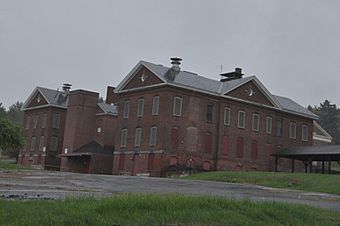Monson Developmental Center facts for kids
Quick facts for kids |
|
|
Monson Developmental Center
|
|
 |
|
| Location | Monson, Massachusetts |
|---|---|
| Built | 1854 |
| Architectural style | Colonial Revival, Classical Revival, Bungalow/Craftsman |
| MPS | Massachusetts State Hospitals And State Schools MPS |
| NRHP reference No. | 93001483 |
| Added to NRHP | January 21, 1994 |
The Monson Developmental Center was a special place in Monson, Massachusetts. It was a state-run facility that helped people who needed support. The land it was built on has been owned by the state since 1854. Over the years, it provided different kinds of care for people who were sick or needed help. The center closed its doors in 2012. Now, the state is looking for new ideas to use the buildings and land.
Contents
Monson Developmental Center History
Early Beginnings
In 1854, the Commonwealth of Massachusetts bought about 175 acres (71 hectares) of land in Monson. They built a large house there called an almshouse. This almshouse was a place for poor immigrants to live. Many of these people were coming from Ireland because of the Great Famine.
In 1855, the almshouse was renamed the State Farm School. Later, it became the State Primary School. It was a home for children who were looked after by the state. This school helped children until 1887.
Growing Over Time
In 1898, a new hospital opened on the same land. It was called the Hospital for Epileptics. This hospital used the old buildings and added many new ones. Epilepsy is a brain condition that can cause seizures.
Over the next 50 years, the facility grew much larger. It expanded to include 72 buildings on 662 acres (268 hectares) of land.
Closure and Future Plans
The property was recognized as important history in 1994. It was added to the National Register of Historic Places. This list includes places that are important to American history.
After 1994, fewer people lived at the center. In 2008, the state decided to close the facility. By 2012, the last 31 residents moved out. The state then started thinking about what to do with the property.
Many of the buildings were old and in bad shape. Some also had a harmful material called asbestos. The state decided to tear down almost half of the buildings. In 2017, the state began asking for ideas. They wanted to find new ways to use about 256 acres (104 hectares) of the land. This area included most of the developed parts of the property.



